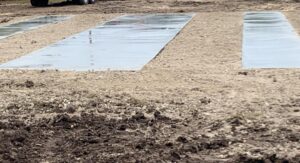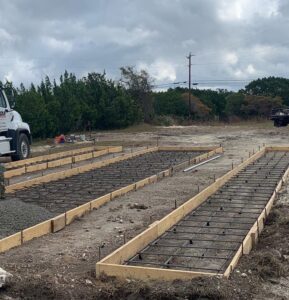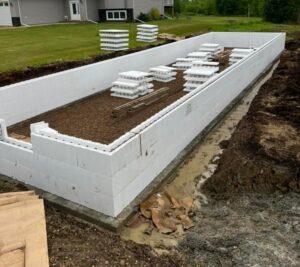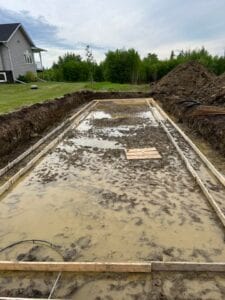Are you aware of the importance of proper mobile home blocking? Did you know that there are legal requirements in place to ensure the safety and stability of these structures? In this article Mobile Home Blocking we will discuss all things regarding your mobile home foundation.
Mobile Home Blocking
Compliance with building codes and installation instructions is crucial. But what exactly does it entail, and why is it so essential? Let’s dive into the world of mobile home blocking requirements.
Mobile home blocking serves a vital purpose – it provides stability, support, and protection against various external factors. By adhering to specific guidelines set by building codes and manufacturers, homeowners can ensure their mobile homes remain structurally sound. Compliance not only guarantees safety but also ensures that cell blocks are properly installed as per industry standards. This introductory guide will explore the factors to consider when determining blocking requirements while shedding light on the benefits associated with this essential practice.
So let’s get started on this journey towards understanding how proper blocking can safeguard your mobile home investment.
Different Types of Mobile Home Foundations and Support Systems Available:
Concrete Slab Foundations for Mobile Homes
One common type of foundation used for mobile homes is a concrete slab. This involves pouring a solid, level surface on which the home can be placed. Concrete slabs provide stability and durability, making them a popular choice for many homeowners. They offer several advantages, including:
Easy installation: Once the site is properly prepared, pouring the concrete is relatively straightforward.
Longevity: A well-built concrete slab can last for decades with minimal maintenance.
Pest resistance: Unlike other types of foundations, such as pier and beam systems, concrete slabs are less susceptible to termite infestations.
However, there are also some disadvantages to consider:
Limited access to utilities: With a concrete slab foundation, it may be more challenging to access plumbing or electrical lines that run beneath the home.
Lack of flexibility: If modifications or repairs need to be made under the house, it can be more difficult due to the solid nature of the foundation.
Pier and Beam Foundation Options
Another option for mobile home foundations is a pier and beam system. This type of foundation consists of individual piers or columns supporting beams that distribute the weight of the home. Some advantages of pier and beam foundations include:
Versatility: Pier and beam foundations allow easier access to utilities since they are elevated off the ground.
Adjustability: If soil conditions change over time, adjustments can be made by adding or removing piers as needed.
Enhanced insulation: The open space between the ground and floor provides an additional layer of insulation against temperature extremes.
However, there are also potential drawbacks associated with this type of foundation:
Vulnerability to pests: The open crawl space beneath a pier and beam foundation can attract rodents or other unwanted critters.
Moisture issues: Without proper ventilation or moisture barriers in place, excessive dampness underneath the home can lead to mold or rot.

Skirting as a Support System for Manufactured Homes
Skirting is another support system commonly used for mobile homes. It involves installing panels around the base of the home to create an enclosed space. Skirting offers several benefits, including:
Aesthetics: Skirting can enhance the appearance of a manufactured home by providing a finished look.
Protection: It helps prevent animals from nesting under the house and protects against debris and pests.
Insulation: Adding insulation to skirting panels can improve energy efficiency and reduce heating and cooling costs.
However, there are some considerations to keep in mind when using skirting as a support system:
Maintenance: Regular inspection and maintenance are necessary to ensure that skirting remains intact and properly sealed.
Ventilation: Proper airflow is crucial to prevent moisture buildup within the enclosed space created by skirting.
Read more on our article Mobile Home Underpinning
Understanding the Minimum Clearance Between Manufactured Home Floor Structure & Ground:
One crucial aspect that homeowners must understand is the minimum clearance between the manufactured home’s floor structure and the ground. This clearance plays a vital role in maintaining the integrity and safety of the mobile home. Let’s dive into why it’s important, how to determine the required minimum clearance, potential issues that can arise from inadequate clearance, and methods to ensure proper clearance.
Importance of maintaining proper clearance under a mobile home
Proper clearance between the floor structure and the ground is essential for several reasons. Firstly, it allows for sufficient ventilation underneath the mobile home, preventing moisture buildup that can lead to mold growth or rotting of wooden components like floor joists. Adequate airflow also helps regulate temperature, reducing the risk of condensation-related problems.

Maintaining proper clearance facilitates easy access for inspections, repairs, and maintenance tasks such as plumbing or electrical work. It ensures that professionals can navigate comfortably beneath the mobile home without any obstructions.
Determining the required minimum clearance based on local regulations
The required minimum clearance may vary depending on local regulations and building codes. It’s crucial to familiarize yourself with these requirements before installing or modifying a manufactured home. Contact your local building department or consult relevant guidelines to determine what specific measurements are mandated in your area.
Keep in mind that certain factors might influence these regulations, such as climate conditions or flood-prone areas. For instance, regions prone to heavy rainfall may have higher minimum clearances to prevent water damage during floods.
Potential issues that can arise from inadequate clearance
Insufficient clearance between a mobile home’s floor structure and the ground can lead to various issues over time. Some common problems include:
Moisture accumulation: Inadequate ventilation due to limited space can trap moisture underneath the mobile home. This excess moisture promotes mold growth and wood decay.
Pest infestations: Insufficient clearance can provide easy access for pests like rodents or insects, leading to potential damage to the structure and insulation.
Inadequate support: If the floor joists are too close to the ground, they may not receive adequate support, potentially causing sagging or structural instability.
Methods to ensure proper clearance between the floor structure and ground
To ensure proper clearance between a mobile home’s floor structure and the ground, consider the following methods:
Manufactured pier heights: Use manufactured piers specifically designed for mobile homes. These adjustable supports allow you to achieve the required minimum clearance while providing stability and load-bearing capacity.
Leveling and blocking: Properly level the mobile home using hydraulic jacks or other suitable equipment. Once leveled, secure it in place using concrete blocks or other approved materials that meet local regulations.
Skirting installation: Install skirting around the perimeter of your mobile home to enclose the space underneath. Skirting helps improve aesthetics while also preventing pests from entering and reducing wind exposure.
Remember, always consult local regulations and guidelines when determining specific requirements for your area.

Properly Blocking, Bracing, and Tying Down a Mobile Home:
Steps for Properly Blocking a Mobile Home
Start by assessing the site where the mobile home will be placed. Check for any uneven ground or potential drainage issues.
Clear the area of any debris or obstructions that could interfere with the blocking process.
Use concrete blocks or concrete block piers to create a stable foundation for the mobile home. These blocks should be placed at strategic locations along the perimeter of the home to evenly distribute its weight.
Ensure that each block is level and properly aligned before moving on to the next one.
Secure the blocks in place by adding mortar between them, providing additional stability.
Importance of Bracing and Tying Down: Mobile Home Blocking
Mobile homes are susceptible to strong winds and other external forces due to their lightweight construction. Therefore, it is crucial to brace and tie down these structures properly.
Install braces along the walls of the mobile home to provide lateral support and prevent shifting during high winds or seismic activity.
Use metal straps or cables to secure these braces firmly to both the frame of the home and its footings.
Pay special attention to bracing areas such as doors, as they are more vulnerable to wind pressure than other parts of the structure.
Consider installing diagonal bracing within wall cavities for added reinforcement against horizontal forces.
Materials commonly used for blocking, bracing, and tie-downs
Concrete blocks: These sturdy blocks are commonly used as a foundation for mobile homes due to their durability and stability.
Concrete block piers: Similar to concrete blocks but designed specifically for supporting mobile homes on raised foundations.
Metal straps: These steel straps provide strength when securing braces between walls and footings.
Cables: Strong steel cables are often used in conjunction with metal straps for tying down mobile homes, providing additional support against wind uplift.
Mortar: Used to secure concrete blocks together, ensuring a solid foundation.

Safety Considerations: Mobile Home Blocking
When performing these tasks, it is essential to prioritize safety:
Always wear appropriate protective gear such as gloves and safety glasses when handling materials or tools.
Use caution when working at heights or in confined spaces.
Follow manufacturer guidelines for the installation of blocking, bracing, and tie-down systems.
Seek professional assistance if you are unsure about any aspect of the process.
By properly blocking, bracing, and tying down a mobile home, you can enhance its stability and protect it from potential damage caused by external forces. Remember to follow the steps outlined above and prioritize safety throughout the process.
Read more on our article Mobile Home Anchors
Perimeter Support Requirements for Mobile Homes:
Different Types of Perimeter Support Systems Available
Perimeter support systems play a crucial role. These systems are designed to provide structural support to the exterior walls of the home, preventing shifting or settling over time. There are several types of perimeter support systems available, each with its own unique features and benefits.
Mobile Home Piers: These are vertical supports that are installed along the perimeter of the mobile home. They typically consist of concrete blocks or adjustable metal piers. Mobile home piers provide stability by transferring the weight of the home to the ground.
Perimeter Pier Supports: These supports are similar to mobile home piers but offer additional reinforcement by connecting multiple piers together with beams or joists. This type of system distributes the weight more evenly and provides increased stability.
Column Piers: Column piers are used in areas where soil conditions may be less stable. They consist of cylindrical concrete columns that extend deep into the ground, providing enhanced support and minimizing movement.
The Role of Perimeter Supports in Stabilizing a Manufactured Home
The primary function of perimeter supports is to stabilize a manufactured home and prevent it from shifting or settling over time. Here’s why these supports are essential:
Weight Distribution: Mobile homes can exert significant pressure on their foundations due to their size and weight. Perimeter support systems distribute this weight evenly, reducing stress on specific areas and preventing damage.
Structural Integrity: By providing additional support along the exterior walls, perimeter supports help maintain the structural integrity of a mobile home, especially during high winds or seismic activity.
Leveling Adjustment: Over time, a mobile home may settle unevenly due to changes in soil conditions or foundation issues. Perimeter supports allow for adjustments, ensuring that the home remains level and balanced.
Factors to Consider When Selecting Appropriate Perimeter Supports
Choosing the right perimeter support system for your mobile home is crucial. Here are some factors to consider:
Pier Spacing: The spacing between piers should be determined based on the weight of the home and local building codes. Consult a professional to ensure proper spacing.
Pier Pads: Adequate pier pads should be used to provide a stable base for the piers. These pads help distribute the weight evenly and prevent sinking or shifting.
Pier Loads: Consider the maximum load-bearing capacity of the piers and ensure they can handle the weight of your mobile home.
Exterior Wall Support: Evaluate how well the selected support system connects with the exterior walls of your mobile home, providing adequate reinforcement.
Mating Wall Openings: Take into account any openings in the exterior walls, such as doors or windows, and choose a perimeter support system that accommodates these features effectively.
Maintenance Tips for Ensuring Long-Lasting Effectiveness
To ensure that your perimeter support system remains effective and durable over time, follow these maintenance tips:
Identifying Problem Areas: Flood Hazard Zones
It’s crucial to be aware of the potential risks posed by flood hazard zones. Living in an area prone to flooding can have serious consequences for your home and safety. To help you navigate this issue, we’ve put together some key points to consider when identifying problem areas related to flood hazards.
Knowing how flood hazard zones can affect mobile homes
Floods can wreak havoc on mobile homes due to their vulnerability to water damage. Understanding the impact of flood hazard zones is crucial for safeguarding your property. Here are some factors to keep in mind:
Water Level: Be aware of the typical water levels during floods in your area. This will give you a better idea of how high the water may rise and what precautions you need to take.
Urban Development: Rapid urban development can alter natural drainage systems, leading to increased risk of flooding. Stay informed about any changes happening around your property that could exacerbate flood hazards.
Soil Composition: Different types of soil absorb and retain water differently. Understanding the soil composition around your mobile home will help you gauge its susceptibility to flooding.
Signs indicating potential flood-prone areas around your property
Identifying signs that indicate potential flood-prone areas near your property is essential for proactive planning and risk mitigation. Look out for these indicators:
Photo Evidence: Historical photographs or images from previous floods can provide valuable insights into areas at higher risk.
Visible Water Flow Paths: Observe the topography around your property for natural channels or depressions that may direct water towards or away from your mobile home.
Crawl Space Openings: Check if there are openings below your home where water might enter during a flood event.
Taking necessary precautions in flood hazard zones
Living in a flood hazard zone requires taking specific precautions to minimize damage and ensure safety. Consider the following recommendations:
Elevate your home: Raising your mobile home on a foundation or piers can help reduce the risk of floodwater entering.
Protect openings: Install flood vents or barriers to prevent water from entering crawl spaces and damaging utilities.
Secure outdoor items: Anchor outdoor furniture, sheds, and other movable structures to avoid them being swept away during floods.
Maintain gutters and downspouts: Ensure proper drainage by regularly cleaning and maintaining your gutters and downspouts.

Emergency preparedness measures specific to flood-prone areas
When living in a flood hazard zone, it’s crucial to be well-prepared for emergencies. Here are some essential steps to take:
Create an emergency plan: Develop a detailed plan that includes evacuation routes, communication methods, and meeting points for your family members.
Prepare an emergency kit: Assemble a kit with essential supplies such as non-perishable food, water, flashlights, batteries, first aid items, and important documents.
Pros and Cons of Permanent vs Non-permanent Foundations for Manufactured Homes:
Benefits of Permanent Foundations for Mobile Homes
Permanent foundations offer several advantages for mobile homes. One of the key benefits is stability. With a permanent foundation, the home is securely anchored to the ground, providing a solid base that can withstand various weather conditions. This stability not only enhances safety but also contributes to a more comfortable living experience.
Another advantage of permanent foundations is their durability. These foundations are typically built using concrete or masonry materials, which are known for their strength and longevity. By investing in a permanent foundation, homeowners can ensure that their mobile homes will stand the test of time.
Permanent foundations often come with added features such as crawl spaces or basements. These extra spaces provide additional storage options and can be utilized as living areas or recreational rooms. They offer homeowners more flexibility in terms of how they use their space.
Flexibility Advantages Offered by Non-permanent Foundations
Non-permanent foundations, on the other hand, offer unique flexibility advantages for manufactured homes. One significant benefit is the ability to relocate the home easily. Unlike permanent foundations, non-permanent ones allow homeowners to move their mobile homes whenever necessary without much hassle.
This flexibility can be particularly beneficial for individuals who frequently change locations due to work or personal reasons. It provides them with the freedom to take their home with them wherever they go, eliminating the need to sell or leave behind their property.
Furthermore, non-permanent foundations often require less time and effort during installation compared to permanent ones. They can be set up relatively quickly and at a lower cost, making them an attractive option for those on a tight budget or looking for immediate housing solutions.
Cost Considerations Associated with Each Type: Mobile Home Blocking
There are differences between permanent and non-permanent foundations for manufactured homes. Permanent foundations generally involve higher upfront costs due to the materials and labor required for construction. However, these investments can pay off in the long run by increasing the home’s value and reducing maintenance expenses.
Non-permanent foundations are typically less expensive to install initially. They often involve simpler construction methods and fewer materials. However, it’s important to keep in mind that they may require more frequent maintenance or repairs over time.
Potential Impact on Resale Value Based on Foundation Choice
The choice of foundation can have an impact on the resale value of a manufactured home. Properties with permanent foundations tend to be more desirable to potential buyers as they offer increased stability and durability. This can result in higher resale values compared to homes with non-permanent foundations.
However, it’s worth noting that the local real estate market and buyer preferences may also influence resale value. In some areas, non-permanent foundations may be more common or even preferred by certain buyers due to their flexibility and affordability.
Conclusion: Mobile Home Blocking
In conclusion, understanding the mobile home blocking requirements is crucial to ensure the safety and stability of your manufactured home. By familiarizing yourself with the different types of foundations and support systems available, you can make an informed decision that suits your needs. Knowing the minimum clearance between the floor structure and the ground helps prevent potential damage.
Properly blocking, bracing, and tying down your mobile home is essential for withstanding various environmental factors such as high winds or seismic activity. Following perimeter support requirements provides additional stability and structural integrity. Identifying problem areas like flood hazard zones allows you to take necessary precautions to safeguard your home.
Consider the pros and cons carefully. Permanent foundations offer long-term stability but may limit mobility, while non-permanent options provide flexibility but might require more maintenance.
To ensure compliance with local regulations and industry standards, consult professionals experienced in mobile home installation. They can provide guidance tailored to your specific location and circumstances. Remember that safety should always be a top priority.
FAQs: Mobile Home Blocking
1. What are some common types of mobile home blocking foundations?
Some common types of mobile home foundations include concrete slab, pier-and-beam, strip footing, and frost-protected shallow foundations (FPSF).
2. How much clearance should there be between my manufactured home’s floor structure and the ground?
The minimum clearance required varies by jurisdiction but typically ranges from 18 inches to 36 inches.
3. How do I properly block and brace my mobile home?
Proper blocking involves using solid concrete blocks or steel piers placed at strategic locations beneath the main beams of your home. Bracing includes securing diagonal steel straps or rods from the main beams to anchors in the ground.
4. Are there any specific requirements for supporting the perimeter of a mobile home?
Yes, perimeter support is crucial for maintaining stability. This may involve installing skirting, using concrete footings, or utilizing other approved methods to ensure proper support around the edges of your home.
5. How can I identify if my mobile home is in a flood hazard zone?
Consult local flood maps or reach out to your local authorities to determine if your property falls within a designated flood hazard zone.
Remember, it’s important to consult professionals and adhere to local regulations. Taking the necessary precautions will help protect your investment and provide peace of mind for years to come.
Be sure to check out our other articles:
